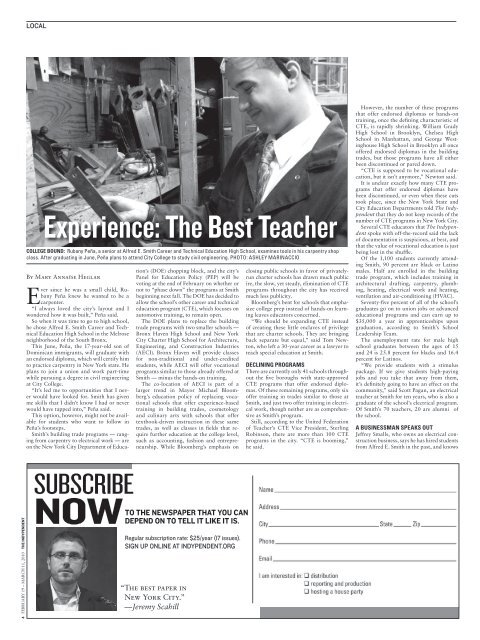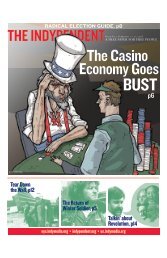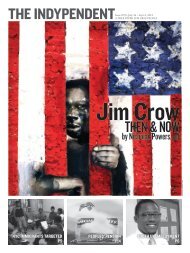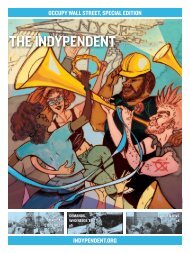Download Issue (pdf) - The Indypendent
Download Issue (pdf) - The Indypendent
Download Issue (pdf) - The Indypendent
Create successful ePaper yourself
Turn your PDF publications into a flip-book with our unique Google optimized e-Paper software.
local<br />
Experience: <strong>The</strong> Best Teacher<br />
college bound: Rubany Peña, a senior at Alfred E. Smith Career and Technical Education High School, examines tools in his carpentry shop<br />
class. After graduating in June, Peña plans to attend City College to study civil engineering. photo: ASHLEY MARINACCIO<br />
By Mary Annaïse Heglar<br />
Ever since he was a small child, Rubany<br />
Peña knew he wanted to be a<br />
carpenter.<br />
“I always loved the city’s layout and I<br />
wondered how it was built,” Peña said.<br />
So when it was time to go to high school,<br />
he chose Alfred E. Smith Career and Technical<br />
Education High School in the Melrose<br />
neighborhood of the South Bronx.<br />
This June, Peña, the 17-year-old son of<br />
Dominican immigrants, will graduate with<br />
an endorsed diploma, which will certify him<br />
to practice carpentry in New York state. He<br />
plans to join a union and work part-time<br />
while pursuing a degree in civil engineering<br />
at City College.<br />
“It’s led me to opportunities that I never<br />
would have looked for. Smith has given<br />
me skills that I didn’t know I had or never<br />
would have tapped into,” Peña said.<br />
This option, however, might not be available<br />
for students who want to follow in<br />
Peña’s footsteps.<br />
Smith’s building trade programs — ranging<br />
from carpentry to electrical work — are<br />
on the New York City Department of Education’s<br />
(DOE) chopping block, and the city’s<br />
Panel for Education Policy (PEP) will be<br />
voting at the end of February on whether or<br />
not to “phase down” the programs at Smith<br />
beginning next fall. <strong>The</strong> DOE has decided to<br />
allow the school’s other career and technical<br />
education program (CTE), which focuses on<br />
automotive training, to remain open.<br />
<strong>The</strong> DOE plans to replace the building<br />
trade programs with two smaller schools —<br />
Bronx Haven High School and New York<br />
City Charter High School for Architecture,<br />
Engineering, and Construction Industries<br />
(aecI). Bronx Haven will provide classes<br />
for non-traditional and under-credited<br />
students, while aecI will offer vocational<br />
programs similar to those already offered at<br />
Smith — minus the hands-on training.<br />
<strong>The</strong> co-location of aecI is part of a<br />
larger trend in Mayor Michael Bloomberg’s<br />
education policy of replacing vocational<br />
schools that offer experience-based<br />
training in building trades, cosmetology<br />
and culinary arts with schools that offer<br />
textbook-driven instruction in these same<br />
trades, as well as classes in fields that require<br />
further education at the college level,<br />
such as accounting, fashion and entrepreneurship.<br />
While Bloomberg’s emphasis on<br />
closing public schools in favor of privatelyrun<br />
charter schools has drawn much public<br />
ire, the slow, yet steady, elimination of CTE<br />
programs throughout the city has received<br />
much less publicity.<br />
Bloomberg’s bent for schools that emphasize<br />
college prep instead of hands-on learning<br />
leaves educators concerned.<br />
“We should be expanding CTE instead<br />
of creating these little enclaves of privilege<br />
that are charter schools. <strong>The</strong>y are bringing<br />
back separate but equal,” said Tom Newton,<br />
who left a 30-year career as a lawyer to<br />
teach special education at Smith.<br />
declining PROGRAMS<br />
<strong>The</strong>re are currently only 41 schools throughout<br />
the five boroughs with state-approved<br />
CTE programs that offer endorsed diplomas.<br />
Of these remaining programs, only six<br />
offer training in trades similar to those at<br />
Smith, and just two offer training in electrical<br />
work, though neither are as comprehensive<br />
as Smith’s program.<br />
Still, according to the United Federation<br />
of Teacher’s CTE Vice President, Sterling<br />
Robinson, there are more than 100 CTE<br />
programs in the city. “CTE is booming,”<br />
he said.<br />
However, the number of these programs<br />
that offer endorsed diplomas or hands-on<br />
training, once the defining characteristic of<br />
CTE, is rapidly shrinking. William Grady<br />
High School in Brooklyn, Chelsea High<br />
School in Manhattan, and George Westinghouse<br />
High School in Brooklyn all once<br />
offered endorsed diplomas in the building<br />
trades, but those programs have all either<br />
been discontinued or pared down.<br />
“CTE is supposed to be vocational education,<br />
but it isn’t anymore,” Newton said.<br />
It is unclear exactly how many CTE programs<br />
that offer endorsed diplomas have<br />
been discontinued, or even when these cuts<br />
took place, since the New York State and<br />
City Education Departments told <strong>The</strong> <strong>Indypendent</strong><br />
that they do not keep records of the<br />
number of CTE programs in New York City.<br />
Several CTE educators that <strong>The</strong> <strong>Indypendent</strong><br />
spoke with off-the-record said the lack<br />
of documentation is suspicious, at best, and<br />
that the value of vocational education is just<br />
being lost in the shuffle.<br />
Of the 1,100 students currently attending<br />
Smith, 90 percent are black or Latino<br />
males. Half are enrolled in the building<br />
trade program, which includes training in<br />
architectural drafting, carpentry, plumbing,<br />
heating, electrical work and heating,<br />
ventilation and air-conditioning (HVac).<br />
Seventy-five percent of all of the school’s<br />
graduates go on to union jobs or advanced<br />
educational programs and can earn up to<br />
$35,000 a year in apprenticeships upon<br />
graduation, according to Smith’s School<br />
Leadership Team.<br />
<strong>The</strong> unemployment rate for male high<br />
school graduates between the ages of 15<br />
and 24 is 25.8 percent for blacks and 16.4<br />
percent for Latinos.<br />
“We provide students with a stimulus<br />
package. If we give students high-paying<br />
jobs and you take that away from them,<br />
it’s definitely going to have an effect on the<br />
community,” said Scott Pagan, an electrical<br />
teacher at Smith for ten years, who is also a<br />
graduate of the school’s electrical program.<br />
Of Smith’s 70 teachers, 20 are alumni of<br />
the school.<br />
a BUSINESSMAN SPEAks OUT<br />
Jeffrey Smalls, who owns an electrical construction<br />
business, says he has hired students<br />
from Alfred E. Smith in the past, and knows<br />
4 February 19 – March 11, 2010 <strong>The</strong> <strong>Indypendent</strong><br />
SUBSCRIBE<br />
NOW<br />
to the newspaper that you can<br />
depend on to tell it like it is.<br />
Regular subscription rate: $25/year (17 issues).<br />
Sign up online at indypendent.org<br />
“<strong>The</strong> best paper in<br />
New York City.”<br />
—Jeremy Scahill












